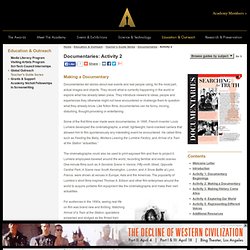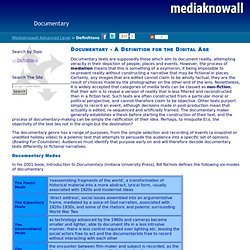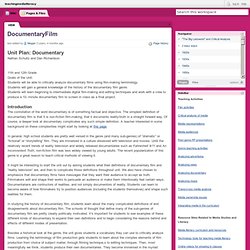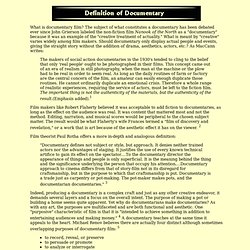

Teacher’s Resource Guide. Making a Documentary Documentaries tell stories about real events and real people using, for the most part, actual images and objects.

They record what is currently happening in the world or explore what has already taken place. They introduce viewers to ideas, people and experiences they otherwise might not have encountered or challenge them to question what they already know. Like fiction films, documentaries can be funny, moving, disturbing, thought-provoking or entertaining. Some of the first films ever made were documentaries. The cinématographe could also be used to print exposed film and then to project it. Nanook of the North (1922) For audiences in the 1890s, seeing real life on film was brand new and thrilling. In 1898, J. Nanook of the North, considered to be the first full-length documentary, has several staged scenes. Because the re-created activities were based on the memories of his subjects, Flaherty felt the resulting film was truthful in spirit. Supplemental Activity. Bowling For Columbine : Now Playing! Bowling for Columbine: Discussion Questions.
Bowling for Columbine : DISCUSSION QUESTIONS 1.

Why does Moore wait 30 minutes to introduce footage of the Columbine massacre? Why not show it earlier in the film? In other words, what does he accomplish in the first 30 minutes of the film that helps prepare us for the montage of the Columbine massacre? 2. 3. 4. 5. Documentary mode. Documentary mode is a conceptual scheme developed by American documentary theorist Bill Nichols that seeks to distinguish particular traits and conventions of various documentary film styles.

Nichols identifies six different documentary 'modes' in his schema: poetic, expository, observational, participatory, reflexive, and performative. While Nichols' discussion of modes does progress chronologically with the order of their appearance in practice, documentary film often returns to themes and devices from previous modes. Therefore, it is inaccurate to think of modes as historical punctuation marks in an evolution towards an ultimate accepted documentary style. Also, modes are not mutually exclusive. There is often significant overlapping between modalities within individual documentary features.
Poetic Mode[edit] Super Size Me. Jack-Ass II Downsizing Morgan Spurlock's Super Size Me Spurlock's no Sherlock Omar Odeh As the latest signpost of the anti-corporate indictment going mainstream through documentary film, Super Size Me recalls a number of related projects like Bowling for Columbine and The Corporation, although the stunt at its core would be equally at home in Jack-Ass: The Movie. The film follows director Morgan Spurlock as he submits himself to a strict diet of McDonald's for 30 days. Media Violence Debates. Bowling for Columbine. Old timers tell of a mystical place not far from here. Health care is provided for all citizens. People take in idyllic winter scenes whilst enjoying jelly doughnuts and long johns with maple icing.
It has a large frontier and a few major cities. Even in these cities people are polite, stand five feet behind you in the ATM line and leave their doors unlocked day and night. There are seven million guns for ten million families, yet homicides from firearms are an eighth that of the United States. Those of us who had heard tales of this frozen utopia were reasonable to be skeptical. Then came Michael Moore’s third feature film, Bowling for Columbine. It turns out that this land of song and story is real. Moore begins at the North Country Bank in northern Michigan. Less than five minutes in, we see another Michigander made good, one Charlton Heston. Michigan isn’t only home to Heston, Moore and Bob Eubanks. English worksheets: Michael Moore´s Bowling for Columbine: Comprehension Questions,Part I. Documentary;—Definitions. Documentary texts are supposedly those which aim to document reality, attempting veracity in their depiction of people, places and events.

However, the process of mediation means that this is something of a oxymoron, it being impossible to re-present reality without constructing a narrative that may be fictional in places. Certainly, any images that are edited cannot claim to be wholly factual, they are the result of choices made by the photographer on the other end of the lens. Nonetheless, it is widely accepted that categories of media texts can be classed as non-fiction, that their aim is to reveal a version of reality that is less filtered and reconstructed than in a fiction text. Such texts are often constructed from a particular moral or political perspective, and cannot therefore claim to be objective. Other texts purport simply to record an event, although decisions made in post-production mean that actuality is edited, re-sequenced and artificially framed. Further Reading. Teachingmedialiteracy / DocumentaryFilm.
Nathan Schultz and Dan Richardson 11th and 12th Grade Goals of the Unit: Students will be able to critically analyze documentary films using film-making terminology.

Students will gain a general knowledge of the history of the documentary film genre. Students will learn beginning to intermediate digital film-making and editing techniques and work with a crew to produce a 10- minute documentary film to screen in class as a final project. New Frontiers in American Documentary Film. What is documentary film?

The subject of what constitutes a documentary has been debated ever since John Grierson labeled the non-fiction film Nanook of the North as a "documentary" because it was an example of the "creative treatment of actuality. " What is meant by "creative" varies widely among film makers. Should documentary only display actual people and events, giving the straight story without the addition of drama, aesthetics, actors, etc.? As MacCann writes: The makers of social action documentaries in the 1930's tended to cling to the belief that only 'real people' ought to be photographed in their films. Film makers like Robert Flaherty believed it was acceptable to add fiction to documentaries, as long as the effect on the audience was real. Film theorist Paul Rotha offers a more in-depth and analogous definition: "Documentary defines not subject or style, but approach.